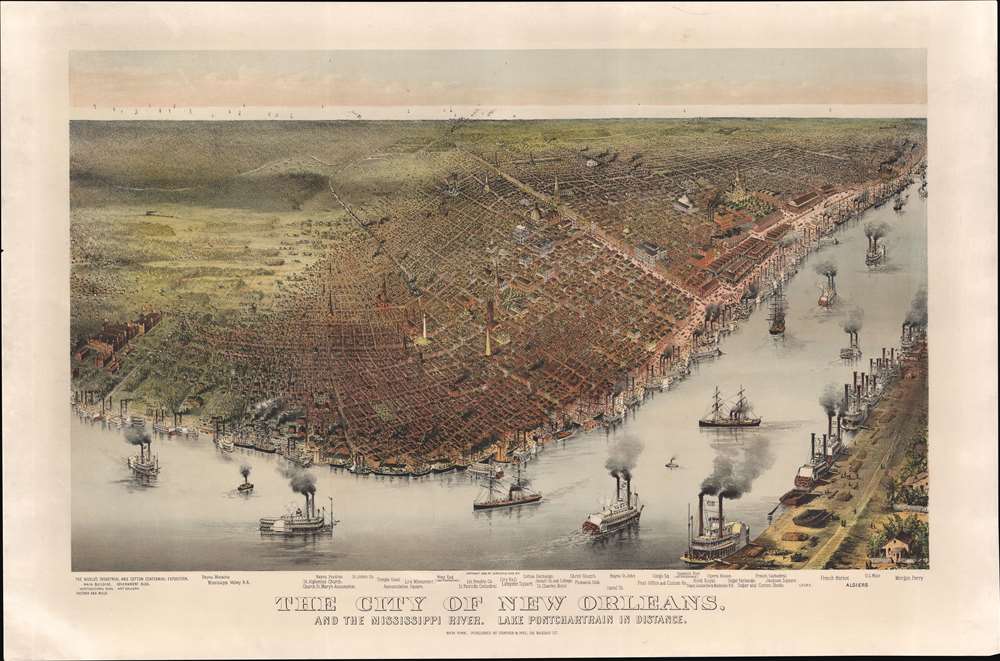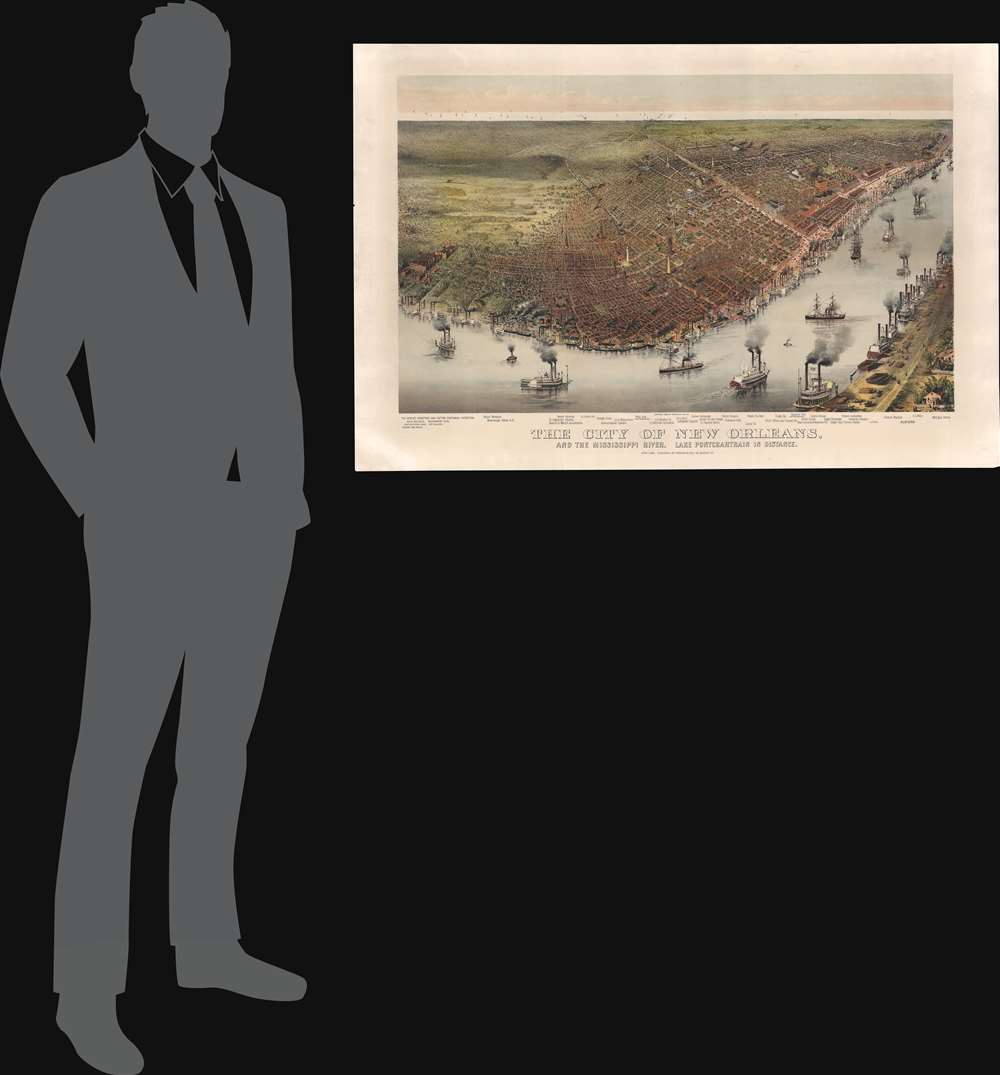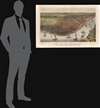This item has been sold, but you can get on the Waitlist to be notified if another example becomes available, or purchase a digital scan.
1885 Currier and Ives Bird's Eye View of New Orleans
NewOrleans-currierives-1885
Title
1885 (dated) 26 x 40 in (66.04 x 101.6 cm)
Description
Industrial and Cotton Centennial Exposition
The Industrial and Cotton Centennial Exposition was a World's Fair held in New Orleans at Audubon Park between December 16, 1884 and May 1885. It was the first world's fair to be held in New Orleans, and was proposed by the National Cotton Planters Association to celebrate the 100th Anniversary of the cotton industry in America. The fair was promoted as an opportunity to demonstrate how well cotton manufactures adapted to Reconstruction with new technology and infrastructure. New Orleans backed the exposition in earnest, cleaning up the streets, installing new buildings, and developing the thirty-three-acre campus at Audubon Park, southwest of the French Quarter. When it opened, the exposition's largest building was also the country's largest building, and the Horticultural Hall was the world's largest greenhouse. The exposition was nonetheless poorly managed. Bidding for vendors did not open until September 1884, meaning that many could not get set up in time for the opening events. More embarrassingly, the organizer, Edward Burke, was accused of fraud shortly after the fair closed and fled to Honduras. Despite receiving some 1,000,000 visitors, the fair itself closed deeply in debt. Even so, although failing financially, it succeeded culturally, accelerating urbanization and modernization in New Orleans and inaugurating an era of prolonged growth.American Bird's-Eye City Views
The tradition of the bird's-eye city view emerged in the United States in the middle part of the 19th century and coincided with the commercial development of lithographic printing. While before the rise of lithography, the ability to own and display artwork in the home was largely limited to the extremely wealthy, lithographic printing made it possible for everyone to own visually striking artwork. A robust trade developed in portraits of political leaders, allegorical and religious images, and city views.City views were being produced in the United States as early as the 1830s, but the genre exploded after the American Civil War (1861 - 1865). Bridging the gap between maps and pictures, most 19th century American Bird's-eye views presented cities to the public high vantage points. Some were imagined, but others were drawn from hot-air balloons or nearby hills. The presentation, combining high elevation, commercial interest, and new printing technology created a uniquely American art form, as described by historian Donald Karshan,
Some print connoisseurs believe that it was only with the advent of the full-blown city-view lithograph that American printmaking reached its first plateau of originality, making a historical contribution to the graphic arts. They cite the differences between the European city-view prints and the expansive American version that reflects a new land and a new attitude toward the land.The vogue for bird's-eye city views lasted from about 1845 to 1920, during which period some 2,400 cities were thus portrayed, some multiple times. Although views were produced in many urban centers, the nexus of view production in the United States was Milwaukee, Wisconsin. The major American viewmakers were Stoner, Wellge, Bailey, Fowler, Hill, Ruger, Koch, Burleigh, Norris, and Morse, among others.
Chromolithography
Chromolithography is a color lithographic technique developed in the mid-19th century. The process involved using multiple lithographic stones, one for each color, to yield a rich composite effect. Oftentimes, the process would start with a black basecoat upon which subsequent colors were layered. Some chromolithographs used 30 or more separate lithographic stones to achieve the desired product. Chromolithograph color could also be effectively blended for even more dramatic results. The process became extremely popular in the late 19th and early 20th centuries, when it emerged as the dominate method of color printing. The vivid color chromolithography produced made it exceptionally effective for advertising and propaganda imagery.Publication History and Census
This view was published by Currier and Ives of New York in 1885 for the World's Industrial and Cotton Centennial Exposition. We are aware of three other surviving examples: A somewhat mangled example at the Library of Congress, another at the Historic New Orleans Collection, and a third in private hands. The view has appeared at auction several times, but it was reproduced in the 1980s and most examples appearing at auction, upon close inspection, have turned out to be from this reissue. The present example is the original five-color chromolithograph issue. Rare.CartographerS
Nathaniel Currier (March 27, 1813 - November 20, 1888) was an American lithographer best known as part of 'Currier and Ives'. Born in Roxbury, Massachusetts, Currier attended public schools until fifteen, when he apprenticed with the Boston lithographic firm of William and John Pendleton. The Pendletons were the first successful lithographers in the United States and were responsible for educating the next generation of lithographic printers. In 1833, Currier left the Pendleton's shop to work with M.E.D. Brown in Philadelphia. A year later, Currier moved to New York City, where he planned to start a business with John Pendleton. When Pendleton backed out, Currier found a new partner, founding 'Currier and Stodart', but the concern survived for just a year. Currier opened his own lithographic studio in 1835 as an eponymous sole-proprietorship. He initially printed the standard materials, including letterheads, sheet music, and handbills. Later in 1835, Currier began issuing current event imagery. Some of his news printers were issued in the New York Sun. By 1840, Currier had moved away from 'job printing' and further toward fine-print publishing. His Awful Conflagration of the Steam Boat 'Lexington', was published in the Sun that year, as well as being separately issued. James Ives (March 5, 1824 - January 3, 1895) began working under Currier in 1850 as a bookkeeper. Ives contributed greatly to the growth of the business, particularly as a manager, marketer, and businessman. Ives became a full partner in 1857, and the firm was renamed 'Currier and Ives'. Currier and Ives produced over 7,500 images and is best remembered for its popular art prints, particularly Christmas scenes and landscapes. They also produced banners, illustrations of current events, views, and historical scenes. Currier retired in 1880 and turned the business over to his son Edward. Currier married Eliza West Farnsworth in 1840, with whom he had one child Edward West Currier. Eliza died in 1843. Currier remarried to Lura Ormsbee in 1847. Other than being a lithographer, Currier also served as a volunteer New York City fireman during the 1850s, and he liked fast horses. More by this mapmaker...
James Merritt Ives (March 5, 1824 - January 3, 1895) was an American businessman, bookkeeper, and lithographer who oversaw the business side of the famed lithographic firm Currier and Ives. Born in New York City, Ives was a self-trained artist who began working at the age of twelve. He married Caroline Clark (1827 - 1896) on June 24, 1846, who was the sister-in-law of Nathaniel Currier's brother, Charles Currier. In 1852, Nathaniel Currier (March 27, 1813 - November 20, 1888) hired Ives as the bookkeeper for his firm N. Currier, Lithographer, on Charles's recommendation. Ives' talent for art and his knowledge of the artistic world soon became apparent to Currier, who valued his insights as well as the business acumen. Currier offered Ives a full partnership in 1857. They renamed the firm 'Currier and Ives' with Ives as the general manager. Ives began to play a role in selecting artists and prints to publish, and was responsible for pursuing publication of scenes of middle-class America that made the firm famous. After Ives died in 1895, his sons continued to work with Currier's son to manage the firm until it was liquidated in 1907. Learn More...




